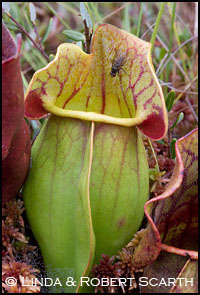introduction - galleries - technique - catalogue - notes - links - contact - blog - deep nature

Pitcher Plant
Getting ?bogged? is something most people avoid. Being stuck in mud, sand or a swamp is a bit scary and certainly inconvenient. However, being in a true bog or fen can be a wonderful, peaceful and naturally engaging experience, with or without photography. Of course, for us there is almost always photography. A bog is a rain fed wetland often having a floating mat of sphagnum moss and other plants around a shallow acidic pond or lake over a peat substrate. A fen is another less acid, peaty, calcareous wetland watered year round by springs or seeps. Both involve peat and are identified by the unique plants that are found in them.
Our most recent wetland adventure was a week in northwestern Wisconsin where several of the many bogs revealed their complex matrices of incredible plants, animals and lyrical beauty. We and other novices followed the odonata experts around for several days at the GLOM (Great Lakes Odonata Meeting) along rivers and in bogs around Grantsburg. This weekend gathering has been happening somewhere in the Great Lakes basin for each of the last six summers. Next year it will be near Chicago. Watch for it. It is a great way to learn about the exquisite occupants of special ecosystems and the people who admire and study them. Dragonflies and damselflies are jewels in the air that become like ?precious stone and metal? works of art when perched for photographs.
Bogs are special by nature, but especially because they are where many of the northern native orchids can be found. The upper Midwest is home to about 50 species of native orchids, many more than Hawaii where all but a handful are imported (a nice way of saying ?alien species?). Many of the northern orchids are little and inconspicuous except when one gets up close and becomes seduced by them as are their insect pollinators. Humans are intrigued by their intricacy and beauty while their pollinators often presume they are desirable members of the opposite sex. There are, however, several spectacular species; chief among them, the Showy Lady?s Slipper (Minnesota?s State Flower) and Grass Pinks (fantastic bright magenta beauties). Northern orchids occur in many habitats, some drier than others, but moist areas including bogs, are good places to search in June and July.
Kissick Bog near Hayward, Wisconsin is an idyllic landscape of dark water, floating moss woven on a matrix of tamarack and spruce roots, nestled in a depression rimmed in hardwoods. The acid level follows a more-to-less gradient from south to north with plants living in their preferred areas along this pH continuum. We photographed four orchid species and saw the faded blossoms of two others on a late June day. In addition to the two mentioned above, there were Rose Pogonia and one of the taller Ladies? Tresses. Many were decorated with white and pink Crab Spiders who lurked and hunted from these colorful vantage points. A Belted Kingfisher complained loudly about the intruders in his domain and a Black Tern patrolled the lake to sweep away the morning mist. It was as lovely as a dream sequence in a moody film.
Pitcher Plants and Sundews also live amidst the sphagnum, where they supply some of their nutrient needs by capturing insects. One Pitcher Plant species looks like freeform urns that potters would call ?organic?. The patterns are lovely with ironwork-like traceries of maroon and green on their plump middles and ruffles on their edges. Just as Bob commented to a fly on the ruffle he was photographing, that it was living dangerously, it slipped and fell into the waiting water vessel. Linda then worked from above to get the fly in focus, and in the frame, as it kicked in circles. Life in the raw ? both in nature and our digital captures.
Nineteenth century gothic fiction portrayed bogs and fens as sinister places where strange and frightening events occur. We encourage anyone to overcome this vision by visiting a bog or fen and meeting the creatures and plants that prosper there. Our favorite Iowa fen will be showing off its gentians, Grass of Parnasas and migrating butterflies in early September. Expect another report from a pair of photographers in rubber boots with wet knees.
? Linda & Robert Scarth, 2006.
First published in NatureScape News, 1 (8), 6, 2006.
